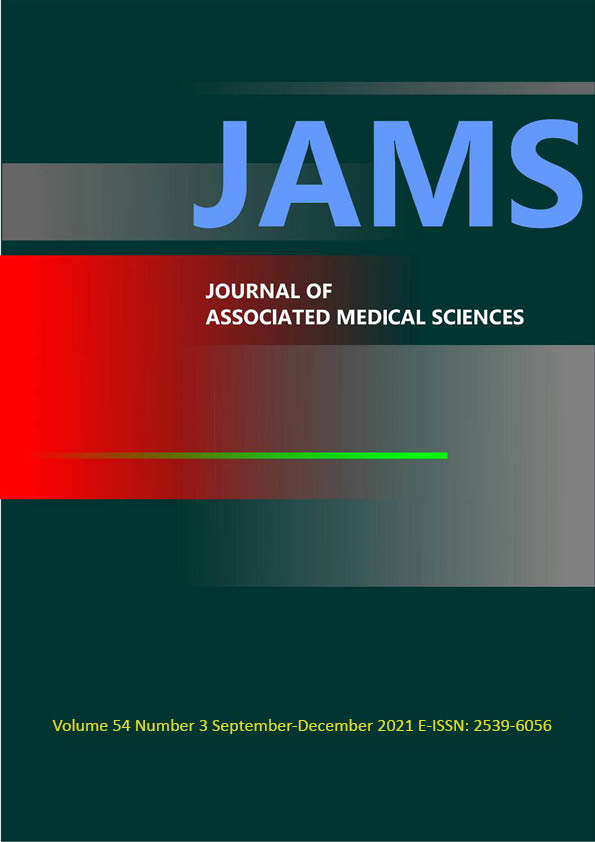Determination of the reference range of whole blood cholinesterase activities in Thai postmortem cases
Main Article Content
Abstract
Background: Whole blood cholinesterase activities are biomarkers for diagnosis of organophosphate and carbamate poisoning. The reference ranges for these biomarkers in Thai people were available for living people. However, there is no baseline data for these biomarkers in Thai postmortem cases.
Objectives: The objective of this study is to study the reference range of whole blood cholinesterase activities in Thai postmortem cases and factors influencing enzyme activities.
Materials and methods: Postmortem blood samples were collected from Thai dead bodies who were 18-60 years old and were sent for medico-legal autopsies at the Department of Forensic Medicine, Siriraj Hospital, Mahidol University between 9th June 2020 and 31st December 2020. Data including gender, age, postmortem interval (PMI) and liver pathology were recorded. Whole blood cholinesterase activities were analyzed by using UV-visible spectrophotometer. Whole blood cholinesterase activities were analyzed using descriptive statistics. Mann-Whitney U test and Kruskal-Wallis H test were also tested for comparison between each factor using statistical significance at p<0.05.
Results: There were 176 subjects recruited in this study (121 males and 55 females). Whole blood cholinesterase activities in all subjects were 3514.32-7771.13 IU/mL and the mean and median values were 6150.27 and 6326.78 IU/mL, respectively. There was significant difference among classified four age groups (p value=0.014). Whole blood cholinesterase activities of two lower age groups (18-30 and 31-40 years old) were significantly lower than the third age group (41-50 years old) (p value=0.027 and 0.005, respectively). Whole blood cholinesterase activities were also significantly related to PMI (p value=0.042). The values from early PMI (0-8 hours) period was significantly lower than the values from the second PMI (8-16 hours) period (p value=0.043). In addition, postmortem cases with fatty change >50% significantly presented lower enzyme activities than those with fatty change <50% (p value=0.042).
Conclusion: Whole blood cholinesterase activities in Thai postmortem cases whose age ranged from 18 to 60 years old were 3514.32-7771.13 IU/mL. Age, PMI and liver pathology were three factors that affect whole blood cholinesterase activities in Thai postmortem cases.
Article Details

This work is licensed under a Creative Commons Attribution-NonCommercial-NoDerivatives 4.0 International License.
Personal views expressed by the contributors in their articles are not necessarily those of the Journal of Associated Medical Sciences, Faculty of Associated Medical Sciences, Chiang Mai University.
References
Assis CRD, Linhares AG, Cabrera MP, Oliveira VM, Silva KCC, Marcuschi M, Maciel Carvalho EVM, Bezerra RS, Carvalho LB Jr. Erythrocyte acetylcholinesterase as biomarker of pesticide exposure: new and forgotten insights. Environ Sci Pollut Res Int. 2018; 25(19): 18364-76. doi: 10.1007/s11356-018-2303-9.
Eddleston M, Buckley NA, Eyer P, Dawson AH. Management of acute organophosphorus pesticide poisoning. Lancet. 2008; 371(9612): 597-607. doi: 10.1016/S0140-6736(07)61202-1.
Kala M. Chapter 16 Pesticides. In: Moffat AC, Osselton MD, Widdop B. editors. Clarke's Analysis of Drugs and Poisons. 4th Ed. London, UK: Pharmaceutical Press; 2011: 258-87.
Aurbek N, Thiermann H, Eyer F, Eyer P, Worek F. Suitability of human butyrylcholinesterase as therapeutic marker and pseudo catalytic scavenger in organophosphate poisoning: a kinetic analysis. Toxicology. 2009; 259(3): 133-9. doi: 10.1016/j.tox.2009.02.014.
Madea B. Methods for determining time of death. Forensic Sci Med Pathol. 2016; 12(4): 451-85. doi: 10.1007/s12024-016-9776-y.
Singhatong S. Acetylcholinesterase and butyrylcholinesterase levels of healthy volunteers who not exposed to pesticides in Chiang Mai Province. J Assoc Med Sci. 2017; 50(2): 168-75.
Hongsibsong S, Kerdnoi T, Polyiem W, Srinual N, Patarasiriwong V, Prapamontol T. Blood cholinesterase activity levels of farmers in winter and hot season of Mae Taeng District, Chiang Mai Province, Thailand. Environ Sci Pollut Res Int. 2018; 25(8): 7129-34. doi: 10.1007/s11356-015-4916-6.
Klette KL, Levine B, Dreka C, Smith ML, Goldberger BA. Cholinesterase activity in postmortem blood as a screening test for organophosphate/chemical weapon exposure. J Forensic Sci. 1993; 38(4): 950-5.
Tani Y, Nagasawa T, Oda H, Ogata K. Distribution and Some Properties of Bacterial Cholinesterase. Agricultural and Biological Chemistry. Agr Biol Chem. 1975; 39(1): 105-11.
Palmiere C, Egger C, Prod'Hom G, Greub G. Bacterial Translocation and Sample Contamination in Postmortem Microbiological Analyses. J Forensic Sci. 2016; 61(2): 367-74. doi: 10.1111/1556-4029.12991.
Pachori P, Gothalwal R, Gandhi P. Emergence of antibiotic resistance Pseudomonas aeruginosa in intensive care unit; a critical review. Genes Dis. 2019 Apr; 6(2): 109-19. doi: 10.1016/j.gendis.2019.04.001.
Janeczek M, Gefen T, Samimi M, Kim G, Weintraub S, Bigio E, Rogalski E, Mesulam MM, Geula C. Variations in Acetylcholinesterase Activity within Human Cortical Pyramidal Neurons Across Age and Cognitive Trajectories. Cereb Cortex. 2018; 28(4): 1329-37. doi: 10.1093/cercor/bhx047.
Meneguz A, Bisso GM, Michalek H. Age-related changes in acetylcholinesterase and its molecular forms in various brain areas of rats. Neurochem Res. 1992; 17(8): 785-90. doi: 10.1007/BF00969013.
Karasova JZ, Maderycova Z, Tumova M, Jun D, Rehacek V, Kuca K, Misik J. Activity of cholinesterases in a young and healthy middle-European population: Relevance for toxicology, pharmacology and clinical praxis. Toxicol Lett. 2017; 277: 24-31. doi: 10.1016/j.toxlet.2017.04.017.
King DW, Socolow EL, Bensch KG. The relation between protein synthesis and lipide accumulation in L strain cells and Ehrlich ascites cells. J Biophys Biochem Cytol. 1959; 5(3): 421-31. doi: 10.1083/jcb.5.3.421.
Linhares AG, Assis CR, Siqueira MT, Bezerra RS, Carvalho LB Jr. Development of a method for extraction and assay of human erythrocyte acetylcholinesterase and pesticide inhibition. Hum Exp Toxicol. 2013; 32(8): 837-45. doi: 10.1177/0960327112468906.


